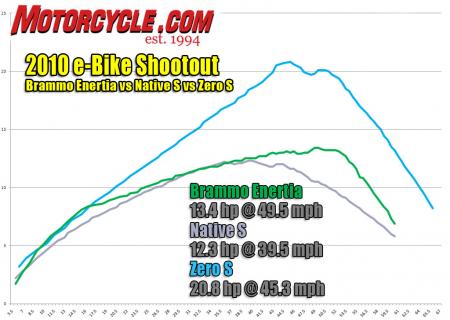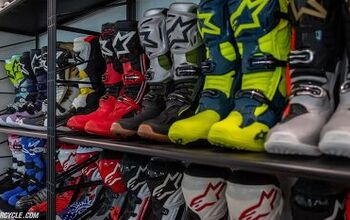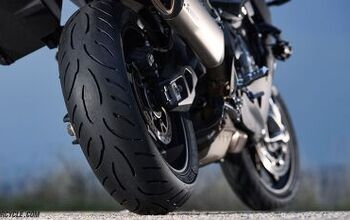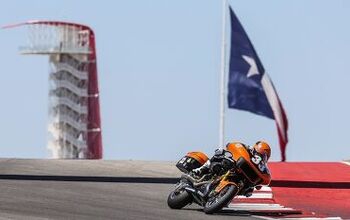Church of MO: 2010 Electric Motorcycle Shootout
As the world turns, dominus vobiscum, it seems we have made quite a bit of progress on the electric bike front over the last ten years, even if it doesn’t always seem like it. Of this trio, only one of which is still standing, the longest range was but 40 miles and the toppest speed only 67 mph. Now, the latest Zero can do way better than that, the Harley-Davidson LiveWire is in play (I don’t think anybody saw that coming ten years ago), Tesla became the most valuable US automaker ever last January – and who knows what Polaris has in store for Brammo, which it acquired in 2015? Herein, the dearly departed 2010 MO crew tries to get a grip on current affairs.
Brammo Enertia vs. Native S vs. Zero S
Who would have thought even three years ago that we’d be comparing three U.S.-manufactured electric street motorcycles priced for popular consumption, and with no less a mission than to change the world?While Zero, Brammo and Native may only sometimes allude to this intent, anyone paying attention to all the rhetoric pouring forth can see this is a goal in which these small startups seriously hope to play a significant role.Accordingly, the Zero S, Brammo Enertia and Native S are part of the gambit by tech sector entrepreneurs wagering that they’ll do for the transportation sector what others among them have already done to transform virtually everything else in this global civilization.
Pioneers
As previously covered in our e-bike primer, these under-$10,000 electric motorcycles were created as the most logical leg-up by environmentally-motivated transportation enthusiasts to start making workable solutions now.
Both Zero and Brammo have benefitted from millions in venture capital to bring reasonably refined products to market. Native, as the off-shoot of Electric Motorsports, is unique in that it’s made from the know-how and parts-sourcing prowess of an electric vehicle (EV) parts distributor.
Included among unknowns to these emerging technology creations are answers to questions about future resale value, long-term durability and reliability. Each of these bikes makes up one big electrical system, with practically as much computing power as a laptop rolling down the road.
On the other hand, they lack many of the complex moving parts in a traditional Internal Combustion Engine (ICE) bike, so potential mechanical pitfalls are actually reduced.
All three makers say they use reliable electrical connectors, and have engineered these bikes to last years and years.
As new battery technology comes along, they’re intended to accept upgrades – assuming this will be truly cost effective during a predicted period of rapid evolution.
Putting the “e” in e-Bikes
The heart of these bikes consists of their air-cooled motors, motor controllers, and batteries with integrated battery management systems (BMS) and on-board charger.
Brammo uses a brushless AC motor from the well-regarded manufacturer, Perm. Zero uses a brushed DC motor from the race-winning Agni Motor company, and Native uses an Etek-style brushed DC motor.
The Enertia is powered by a 72-volt lithium iron magnesium phosphate battery system that’s made with components sourced from Texas-based Valence. It weighs 86 lbs, and is comprised of six modules in series. Each contains 120 “18650” cells for a total of 720 cells tied together to make one 3.2 kWh system. Zero’s founder, and former NASA engineer, Neal Saiki developed a 4.0 kWh, landfill-approved 58-volt lithium-ion manganese battery for his Zero S ( and Zero DS). This 90-lb powerpack is made up of 336 cells, Saiki says. The Native’s 72-volt, 3.2 kWh lithium iron phosphate battery also weighs about 90 lbs, and utilizes 24 large format cells supplied by the Chinese EV power manufacturer, Thundersky.
About Those Super Expensive Batteries
These e-bikes’ battery systems account for about one third of their weight and 30-40% of their purchase price. As a discerning shopper, would you like to learn more about them?
To begin with, they have less energy density than those intended for consumer electronics, but can deliver as much as six times the number of charge cycles as some laptop batteries, for example, so they should last longer. They are also better protected against “thermal runaway” that can cause consumer electronic batteries to burst into difficult-to-extinguish flames.
When thinking of li-on batteries, understand these are not mere cells, but closely-monitored systems built around the cells. As such, their BMS regulates discharging and recharging, and prevents deep discharge or over-charging respectively. Typically, these battery packs are permitted to discharge 80% of their total voltage, with 20% remaining. Depleting them further becomes potentially damaging, so the system prevents that.
The Native S battery is rated at 3,000 charge cycles, the Brammo Enertia’s is rated at 2,000 charge cycles, the Zero S battery is rated at 1,800 charge cycles.
When a manufacturer describes the number of “charge cycles” a particular battery can take in its lifetime, the estimate is based on a full discharge (to 80% depletion), and a full recharge.
Harlan Flagg, an electrical engineer, and partner at the Los Angeles-based e-bike dealership, Hollywood Electrics says that topping off a battery after less than a full discharge does not necessarily count toward the estimated total. More frequent recharging should therefore extend the lifespan of an e-bike’s battery, he says, using the Brammo Enertia’s 2,000 charge cycle rating as an example.
“They’re talking about full charge cycles. If you ride this thing, and only deplete the battery to 20%, [instead of 80%] some of these batteries can make 10,000 charge cycles,” Flagg says, adding that this is only a rough estimate.
In fact, battery life – just like real life – is not black and white, Flagg say, elaborating on what may reasonably be expected.
“I think that for a lot of these batteries, you’re going to be reaching your maximum capacity after like maybe 50 cycles,” he says, “and then after 50 cycles that’s when, you know, you’re talking about it’s going to start dropping off.”
Decreases in charge holding capacity will be imperceptible, and may not be noticed for years, Flagg says. Li-ion batteries are the least susceptible to memory and gradual degradation, but they are not immune.
And even a battery that’s considered fully used still retains a fair percentage of its usable power.
“After 2,000 cycles you’re only going to have 80% of your battery capacity, so you’re still going to have 80% of your range, which isn’t too bad,” Flagg says, “It’s not that after 2,000 cycles this battery is going to be completely dead, and it’s going to be just a worthless brick sitting in your garage.”
e-Biking in Paradise
The Motorcycle.com crew took on this atypical evaluation by e-cruising between SoCal beach towns on milder than usual shake-down runs. We’d already experienced an Enertia that left us flat after 24 miles of what we thought was moderate use, and didn’t want to push our e-bikes’ estimated range of 20-40 miles (based on how hard you use them).
Each of these single-geared machines is light, and unintimidating – for the most part. Both Duke and Speedy Pete found the Zero’s 34-inch-high saddle too tall to flat foot with their 5-foot, 8-inch frames, and disliked the squared-off edges of its Corbin saddle.
Both the Brammo and Native are lower to the ground, but Duke was less than enthralled with the Brammo too.
“The Enertia’s saddle (with attractive white stitching) is too hard, especially for a vehicle designed for short hops,” he says, “Legroom is generous due to a seat that is taller than it needs to be. Really short people won’t like that.”
On the other hand, at 6-feet-tall, I fit the Enertia fine, and never felt any discomfort.
As short-range runabouts, these machines offer reasonable utility and a fair degree of sophistication. The Zero’s work-of art brushed alloy perimeter frame and matching swingarm, designed by company founder Neal Saiki, are held up by an inverted fork and rather light-duty monoshock – each made by FastAce, and offering 8 inches of travel for the 56.8 wheelbase e-motard.
Not far behind is the Brammo Enertia’s nicely-designed black-finished alloy perimeter frame. Its 56-inch wheelbase is suspended by a Marzocchi Shiver inverted fork, and Elka shock offering a more street-oriented (and reasonable) five inches of front/rear travel.
The Native’s steel perimeter frame and aluminum alloy box-section swingarm balance between an upside down fork and twin rear shocks that are adequate for this 51.75-inch wheelbase machine.
Riding Down to Electric Avenue
Start-up for the 275-lb Zero is as simple as turning a key. The 285-lb Native is also easy, with the additional step of pushing a button. The 324-lb Brammo adds a “start-up sound” for this “laptop on wheels” upon boot up, and more buttons and switches to sequence through. Brammo says this extra complication is to prevent accidental acceleration from the machine which, like them all, is silent when powered up.
All three offer instruments displaying a fair degree of data, in addition to the usual speed and trip distance – with no tach needed.
The Zero and Brammo offer not only on-road energy data, but also show status while charging – indicating charge of the battery, with the Enertia even showing state of charge for individual cells. The Native offers only a state of charge meter.
Acceleration from a stop shows the 20.8-hp Zero to be a king among flyweights (see video), and its top speed of 67 mph (some have seen as high as 71 mph), bests the 13.4-hp Brammo’s 63 mph, and the 12.3-hp Native’s 60 mph top speed.
None is a sportbike, but of the three, the Zero, with its dirtbike-like seating position, broad alloy pegs, fairly sticky Duro-branded 110/70-16 front and 140/70-16 rear tire seems confidence inspiring with the most ground clearance.
At least, this is my view, filtered through my ever-adaptable use-the-tool-you’ve-been-given attitude.
However, Brissette objected to the Zero’s perceived heavy steering, high center of gravity and more.
“When riding in a straight line I found I constantly had to center the front wheel, Pete says, “The bike had a tendency to migrate left or right of center. Kevin suggested this issue could be overly tight steering head bearings.”
Otherwise, Kevin had good things to say about it.
“Of this trio, the Zero S feels closest to my enthusiasts’ proclivity,” he says, “It feels like a real motorcycle, and its lovely aluminum frame and swingarm wouldn’t look out of place on an Aprilia, and it has the highest top speed – it makes an experienced rider feel most at home.”
We also liked the Brammo, which falls neutrally into turns – albeit with limited steering lock which makes on-street turnarounds tight. Otherwise, it’s confidence inspiring, and will eventually drag its lower alloy platform pegs which complete its Sportster-like riding position. Its 100/90-18 front and130/80-17 rear Avon Road Rider Tires offer adequate grip for city/suburban purposes.
Of the three, the Native feels most diminutive, while offering a sporty and purposeful riding position – although it’s too compact for my 6-foot frame.
“It has a newbie-friendly riding position,” Kevin notes, “with a low seat that will appeal to shorties, but its short seat-to-peg distance won’t suit tall riders.”
Oddly, the Native is the only one with a passenger seat and pegs. If intending to carry a friend on the Native, make sure she’s light, or you don’t plan to travel very far.
Limitations aside, Pete especially liked the Native, and found it to be “the most neutral and best handling of the three.”
Its narrow 90/80-17 front and 100/80-17 rear IRC EagleGrip tires made steering super easy, and contribute to its range and speed, having the least rolling resistance. When nursed at moderate speeds, this bike has been known to go as far as 50 miles on a full charge, which the Zero would be hard pressed to match and the Brammo never could.
“Considering the relative lack of capital Native is working with compared to its higher-profile rivals, its S proves to be a very usable and competitive design,” Kevin observes. “This said, it falls a bit short by feeling like more of a kit bike than a cohesive package.”
All these bikes have hydraulic front and rear disc brakes with the Brammo’s Brembos being tops. The Native’s Tiger-branded binders are next in stopping power, and the Zero’s Hayes stoppers left us scratching our heads.
Sure, Zero has evolved e-bikes from mountain bikes to dirt bikes, and now is selling these light street bikes – sped’d as all Zeros are, with a bias toward the lightest parts available within reasonable costs. But squeezing the bantamweight front binder is uninspiring, and attempting one little stoppie ruined the whole day. The system lost half its lever feel as though a big air bubble got in the line. It left us thinking this otherwise competent bike should get an upgrade on par with what the Brammo comes with stock.
A Few More Details
Each bike has redeeming characteristics and shortcomings.
For example, the Native’s throttle response is notchy, and not as progressive as the Zero’s or Brammo’s.
It’s a curiosity to this new breed of motorcycle that while they attempt to imitate traditional ICE machines, they may randomly go off in their own design directions seemingly for no other reason than to be innovative, or merely different.
Take, for instance, Zero’s lightweight brake rotors designed by Saiki with “cooling fingers.” The idea of reduced braking temperatures was good, but rather than designing original components, wouldn’t it have been more effective to spec off-the-shelf? The focus on trick rotors seems particularly wasted considering the rest of the system’s performance is barely adequate.
Similarly, the Zero’s square-tubed alloy kickstand seems like overkill to some MO staffers, but alternately could be looked at as burley and unique. The same could be said of the Brammo’s cast kickstand with “Brammo” embossed as evidence of yet another high-quality touch to this most thoroughly-sorted machine.
On the other hand, the Enertia’s green jellybean appearance may or may not work for traditionalists – but then, if rumors are true, what young rider would care?
In the e-bike race pits a short while ago at the FIM e-Power race at Laguna Seca, some enthusiasts were going on about how eco-friendly bikes are “chick magnets” and good for meeting people with a disposition toward green thinking.
If we find this conjecture to be true, we’ll be sure to drop our endorsements for pheromone-laced cologne, and “how to meet your match” video tutorials in favor of the E-Bike Factor.
Yes, among things we’re waiting to see is whether they will help with personal relationships, social image, and an overall sense of well-being.
In any event, you can get help finding out the answers to these questions and more with financial aid from Uncle Sam and a growing list of state governments by way of tax incentives and rebates.
Conclusion
In all seriousness, potential consumers can make their own minds up about fit and aesthetic considerations, but we otherwise feel most confident with the $7,995 Brammo Enertia, over the $9,995 Zero and $7,500 Native S, in this order.
Although not able to match the Zero’s power-to-weight ratio, and lacking some of the assiduously thought out weight-saving details, the Brammo has its own qualities and is the most all-around solid. If the Zero had better brakes and suspension, it would have been closer, but despite the Brammo’s slightly lower range potential, its 20% lower price tips us over the edge in its favor.
“The Enertia feels solid and well-engineered,” Kevin comments. “It’s what I imagine Honda might’ve built if it had taken the plunge as early as Brammo.”
Further, Brammo’s dealer support may be best, especially if the company’s plans to roll out a national network come to pass. Zero’s determination to make all sales flow through its California Web-based distribution model along with regional sales reps is questionable, and the Native has spotty support as well.
Any one of these bikes should be investigated further – and based on new offerings from Brammo already, and promises by Zero for 2011, who knows what innovations next season’s models may offer in this rapidly developing field?
To be sure, it’s an unusual time, in which questions arise faster than we can provide answers, so we’ll just cut it here: At this juncture at the dawn of the proposed EV revolution, our e-bike pick of the day is the Brammo Enertia.
Related Reading
Electric Motorcycles Primer
2010 Native S Review
2010 Zero S and DS Review
2010 Brammo Enertia Review
2010 Brammo Empulse Preview
Zero S Officially Announced
2008 Zero X Electric Motorcycle Review
More by John Burns















































Comments
Join the conversation
Wasn't Brammo bought up by Polaris, then integrated in the Victory brand, and subsequently killed off with the rest of Victory?
And whatever happened to Native?
So of the 3 electric bike brands 10 years ago, only Zero is left standing.
Neat to look back at the old articles and see how far tech advances.